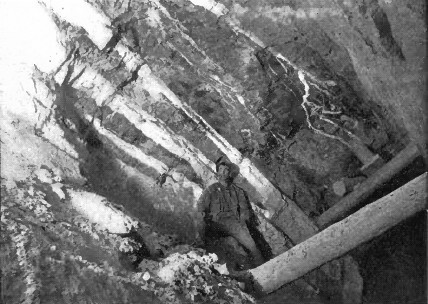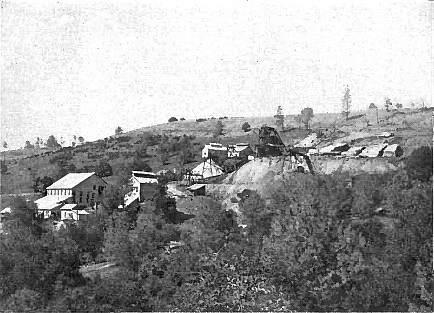The first requisite in purchasing a mill is that the buyer should know what he wants. Some buyers want to put up a mill for the purpose of being better able to sell stock in their mines, and so want as cheap a mill as possible, while other buyers want a mill to obtain the metals from their ores, and so want as efficient a mill as possible. The latter must comprehensively sample their ore bodies and turn the samples over to a metallurgist for testing to determine the proper process. This is one of the critical stages in the development of a mine, and requires scrupulous care and study. It is essential that the samples shall represent the average of the ore to be milled. If a pay shoot or vein is but 12 inches wide, it is foolish to sample the pay shoot only, without taking into consideration the impossibility of mining a pay shoot of that width without including a certain amount of waste. And yet this is done over and over again. Ores that will 'assay' $8 to $10 are found to 'mill' but $2 to $3, so that the disappointed stockholders shake their heads and resolve to have nothing more to do with mining investments.
The sampling should be performed under the direction of the superintendent or mining engineer in conjunction with the metallurgist, for the first two should know the grade of the ore and what ore it is expected to send to the mill, while the wide-awake metallurgist acquires a knowledge of the nature and characteristics of the ore and the proportions of the different kinds of ore that will be supplied to the mill, and can call attention to any mistake in selecting the samples.
After the samples have been tested by the metallurgist and the proper treatment system and machinery outlined by him, the next step is the designing of the mill and the purchase of the apparatus. The mill should be designed by a mechanical engineer who has specialized in this line, and his work should be outlined and directed by the metallurgist. The metallurgist is a man who has worked with the process in many fields, and has an up-to-date and working knowledge of the appliances that may be used. But, generally speaking, the metallurgist cannot calculate in a practical way the strength of materials, or determine what the chords of a roof truss should be, or the proper size and arrangements of the driving parts, or the proper foundations for the machinery, etc. Obviously these things are the work of the mechanical engineer, who is a specialist in them.
And the closer in touch that the metallurgist and the mechanical engineer work, the better will be the results. The final work of designing consists in drawing up a complete list of specifications, giving the quantities and sizes of the different parts or devices required, and particularly specifying their material and methods of manufacture. With this list in hand the buyer knows what he wants. However, the entire question of building a mill is so bound up with the manufacturer of mill machinery, that a correct understanding of his functions is necessary. The machinery manufacturer lives by selling machinery, and years of experience have taught him that he must proceed along certain lines. One of these is that he must keep a force of mechanical engineers and designers, and submit mill designs and give advice to prospective buyers free of charge. It is always well to seek the advice of the manufacturer, as much money may be saved by using his standard product and patterns wherever they may be found applicable. But the representatives of the buyer should be the men who draw up the plans and specifications, not the manufacturer, for the manufacturer cannot assume the responsibility for the successful operation of the plant in addition to his own responsibilities, and so it will invariably be found when it comes to signing a contract that the manufacturer will only "guarantee the workmanship and material to be free from defects when used for the purpose ordered." There will seldom be any guarantee of tonnage output, and never a guarantee of any degree or percentage of extraction; the responsibility for the mill 's successful operation, outside of failure due to defective material and workmanship, rests with the buyer and his representatives.
The buyers of small plants seldom appreciate these facts, and in order to economize upon the cost of engineering services, will frequently submit their own general ideas as to the proper treatment to the machinery manufacturer in order to obtain advice for nothing. The manufacturer under such conditions does the best he can. He must, perforce, assume the buyer's statement of conditions to be correct, and devise a plant accordingly. He knows, of course, that the buyer is telling the same story to other manufacturers and that, therefore, there is no chance that all will bid upon a uniform set of specifications. Each manufacturer bids upon what in his opinion is the cheapest plant that can be put up. He keeps his bid as low as possible, partly by the use of cheap material and a scant design, and mainly by eliminating every item possible, even the most necessary accessories are often omitted. It should be clearly understood that the manufacturer indulges in no guesswork in making his bid, but does it by setting down each item of machinery and parts that he will supply and the price that he can sell it for, and then obtaining the sum total of the items. Obviously, the more items he can eliminate, the lower will be the bid. A large majority of buyers of this type will hastily turn over the pages of the specifications until they come to the last page. Then scrutinizing the final figures or lump-sum bid, will wonder why A can furnish a 'complete' mill so much more cheaply than B and promptly proceed to give A the order. The eventual result is that it will cost the buyer from 15 to 50% additional for extra machinery and accessories, repairs and alterations, and the loss of time in getting mill fitted up and into commission is a matter of even more serious consequence.
This type of buyer is a severe tax on the conscience of the manufacturer, who has learned to recognize the type on sight and to act accordingly. He also knows that a buyer showing so little intelligence in buying is apt to have shown but little more in developing his mine, and that the mill will probably not operate more than six months, not that the machinery installed is inadequate or defective, but that the buyer has neglected to provide himself with a mine. As a rule machinery manufacturers are honest, but professional mill builders recognize that great dissatisfaction arises in putting up the mills of certain manufacturers, while workaday mill men speak of the mill put out by certain manufacturers as bunglesome and unsatisfactory of operation because of poor material and bad design. All of which tends to prove that a mill should be purchased on merit of a reputable manufacturer. Having purchased the mill, the next step is its erection by a competent millwright or mill erector, who should work in conjunction with the metallurgist or mill man who is to put the mill into commission, at least the assistance of the mill man should be sought as the mill nears completion. This is for the reason that the mill man has certain detailed knowledge which can hardly be expected in the erector or millwright, also because there are a great many small details of construction and arrangement which the mill man requires to satisfy his own personal ideas and which he will make sooner or later.
It has been stated that a metallurgist or metallurgical engineer should test the ore and outline the treatment system and machinery. That a mechanical engineer, working under the advice of the metallurgical engineer should design the mill and draw up the specifications. That the specifications should be submitted to the manufacturers for bids upon each item of the quality specified. Finally, that the mill should be erected by a millwright or mill erector working with the advice of the mill man who is going to operate the mill. This applies admirably to mills of medium and large size, but by far the greater proportion of mills vary in size between 2 and 20 stamps. In building small mills embodying only standardized stamp-milling and concentration, financial and other conditions may be considered not to warrant such extensive engineering service. In such cases the mill plans will doubtlessly be furnished by the machinery manufacturer, but the plans and specifications should be checked by the experienced men who will build and operate the mill, while the mill should be purchased on merit and individual specifications and not on a lump-sum bid.
Continue on to:
Properties and Care of Mercury And Its Amalgamation On Plates
Return To:
Hard Rock Quartz Mining and Milling


